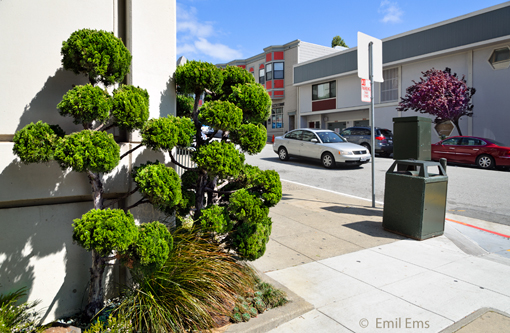
8 Japan Town
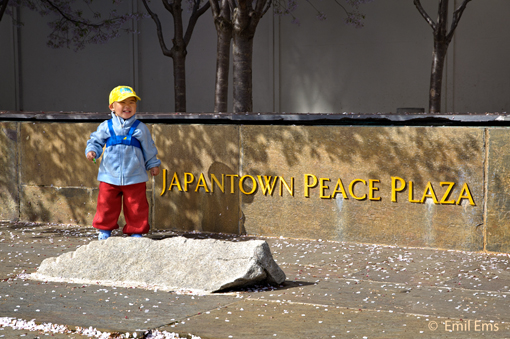 Please click on any image to enlarge it!
Please click on any image to enlarge it!
The day after my photographic excesses with flowers in the rain (Chapter 7), my Japanese landlady, who had business in San Francisco to attend, invited me to join her in a visit to Japan Town, a small Japanese enclave in the centre. To this effect she sorted her fire red Toyota from the garage and proudly invited me into the cabin of this excellent two-seater.
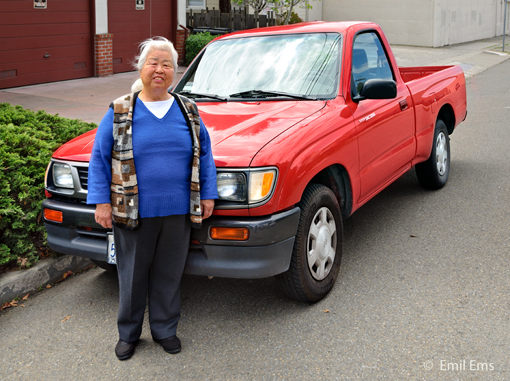
Off we went down Ashby Avenue and on to the freeway leading to Bay Bridge. Just before a huge toll station, Nobuko explained to me that a car full with passengers was exempted from the substantial bridge charge. Two-seaters, with appropriate cargo room in the back, were as made for this condition, since it took only one passenger to get a free ride across the bridge. She added that her car had attracted many prospective buyers since it also, besides the above mentioned advantage, was well kept and looked like new. I soon could confirm this when parking the car upon our arrival, since we immediately got hooting and applause from a passing vehicle.

But I am rushing ahead of events. Back to where we left off at the toll station! After whooshing on a sidetrack past a serious queue of paying vehicles, we soon sailed across Bay Bridge, an impressive edifice, indeed.

It spans the Bay in two wide arches, with the middle part securely fastened to two small islands, one of which carries the intriguing name of Treasure Island. After having left the bridge behind us, it was surprisingly easy to approach the centre of San Francisco, since Freeway 101 reaches almost all the way in.
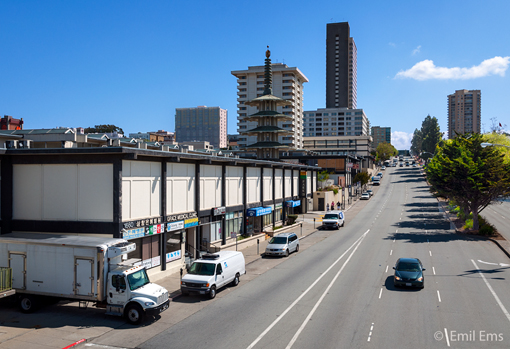
Japan town lies on Geary Street, just a few blocks from the freeway run-off. You would be mistaken to expect an exotic relic of historical buildings with Asian flair. This is not a miniature version of Kyoto; rather, the commercial quarters of Tokyo come to mind as an apt comparison. The quarter is dominated by a huge – at least in European terms – shopping centre, straddling several blocks.
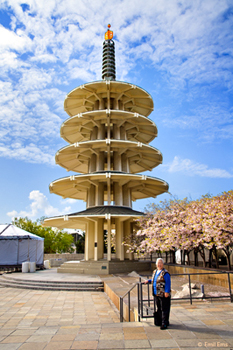
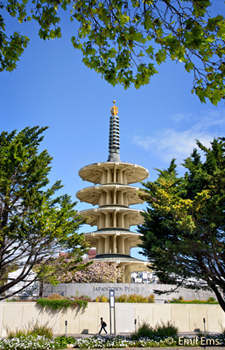
Pagoda, as seen from Polk Street ... and from Geary Boulevard
In its middle, an intriguing Pagoda strives for the sky, built in raw concrete like the other edifices within the centre. The architectural style of all this comes closest to, let’s say, pre-post-modern modern. The only architectural manifest of old Japan, albeit on concrete pillars, is to be found a block away, along Sutter Street, in a gentle Torii, the arch traditionally guarding a Shinto shrine.
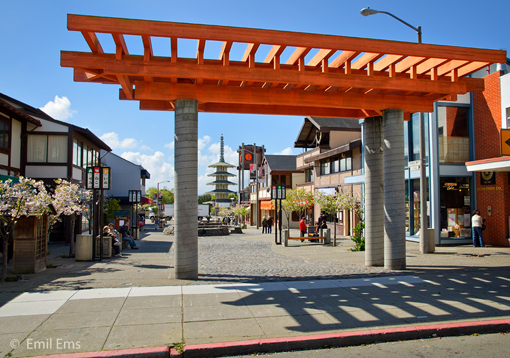
For those of you not familiar with the precise meaning of this construction, I had been told, during my visit to Japan in the nineties, that Torii was a manifestation of one of the oldest still-practised religions in the world. It represented no other than the perch of the “Urhenne”, the Original Hen, who had laid the world as its egg. We stand aghast at such ancient wisdom of maintaining a religion intact throughout the ages and letting it mature in line with the development of humanity, rather than letting it be overthrown by more recent, far too eager, generations, as was the case in Europe some 1700 years ago.

In line with this, the whole neighbourhood breathes gentile calm, aided by a population that, at least during daytime, consists mostly of people of certain seniority, still very Japanese in clothing and behaviour.
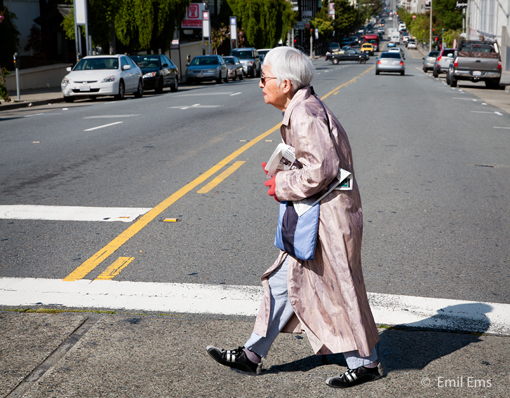
Whilst strolling along a few of the side streets, I happened upon two true philosophers, one of them a street sweeper of Philippine origin and the other his Japanese friend. In a friendly banter between strangers, I made the mistake of challenging them on the valour of Buddhism, maintaining that this religion, which held the promise of complete disintegration into nothingness as sole remedy against the fear of death, hardly represented a valid consolation for a tortured elderly person, like myself, already glimpsing his inevitable demise.
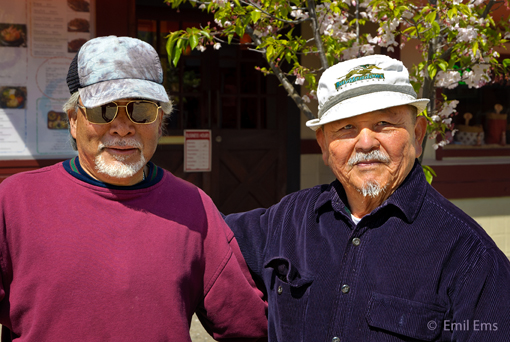
Their gentle rebuttal was that, in contrast to Christianity and other juvenile beliefs, a man seriously embarking on bettering himself would, in case of failure, have both a second, third, fourth and so forth chance, until circumstances, as well as strong spiritual discipline, kept him on the right road to Nirvana. Confronted with such superior wisdom I had to acknowledge defeat and we went our separate ways as friends.

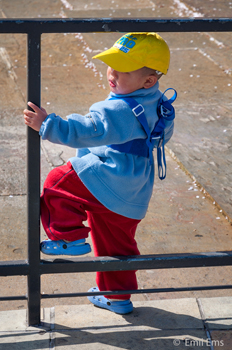
Encouraged by this spiritual intercourse I took a short walk with the aim of achieving a more harmonious view of the Pagoda than that provided from within the Japan quarters. After gaining a healthy distance from the shopping centre, I finally succeeded, across a heavily trafficked six-lane avenue and using my telephoto lens, in placing this worthy religious symbol into a more fitting surrounding (See earlier picture of the pagoda, seen from Geary Boulevard).
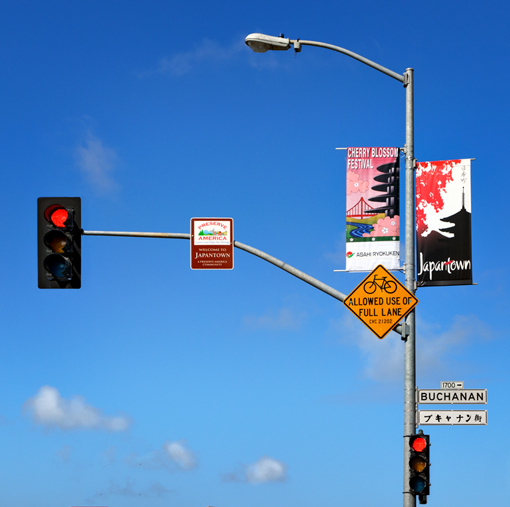
With still some time to spare before reuniting with Nobuko, I bought a coffee and glanced in a brochure laying out the plan for the forthcoming Cherry Blossom Festival. This reminded me of 1977, when Alice and myself, by pure chance, happened to be in the neighbourhood as a grand street parade took off, which I have kept in fond memory as well as kept documented in an often admired slide show. I decided on the spot that it would do me some good to revisit that parade the following Sunday and I was hoping for an event at least as grand as that of 1977. More about this in a following chapter.
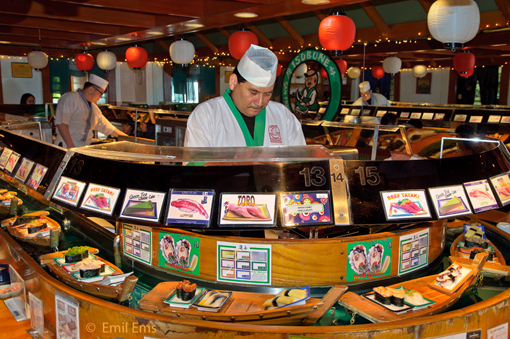
Upon her return, Nobuko generously invited me to lunch in a traditional Sushi restaurant. The variety of plates that were presented us by small ships sailing past before our noses, without interruption, was stupendous. I did not recognise even half of the dishes, despite having frequented Japanese restaurants in Brussels and Stockholm often enough. Thus was revealed a piece of the real Japan. Sophistication in food preparation always was and always will be, in my eyes, the true essence of Nippon.
